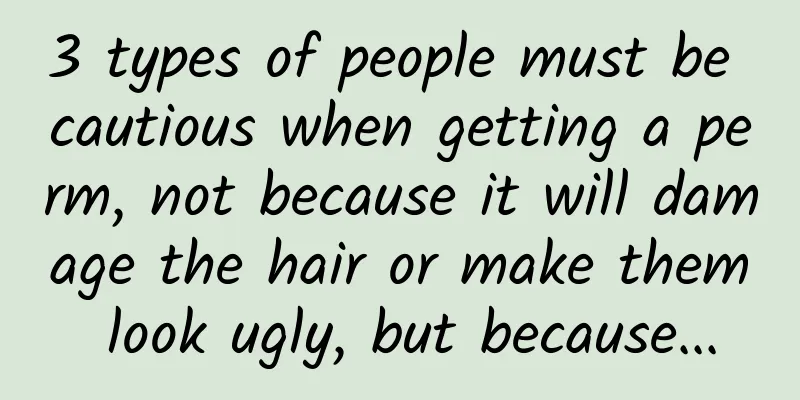3 types of people must be cautious when getting a perm, not because it will damage the hair or make them look ugly, but because...

|
As the saying goes, the three things you need for Chinese New Year are hair perms, manicures, and eyelash extensions. As the end of the year approaches, many people have already put hair perms on their agenda. In recent days, many topics related to perming have been trending on Weibo, including #Three-piece set for Chinese New Year: perm, manicure and eyelash extensions#, #Is perming Chinese New Year a standard for aunties in Northeast China#, and #2 girls got a perm to welcome the New Year but were left crying after 9 hours of being ugly#, sparking widespread heated discussions among netizens. Image source: Weibo screenshot It is not uncommon for perming to cause physical or chemical damage to hair. Many netizens have complained about their perm failures in the comment section, and some are worried about whether perming will bring health risks. So, what should you pay attention to when getting a perm? Who should not get a perm? How can you save your dry and parched hair after a perm? The origin of perming and the structure of human hair Perming has a long history. As early as 2,000 years ago, women in ancient Egypt learned how to perm their hair. Perming became fashionable more than 100 years ago. In 1872, Parisian barber Marcel Gratte invented a pair of pliers that could make hair curly by applying a potion to the hair and heating it with the electric pliers. This pair of pliers was the popular "perm machine". Now that we understand the origin of perm, let’s talk about the structure of hair so that everyone can better understand the impact of perm on hair. The 3 structures of hair are from freepik, by artmbi As can be seen from the above picture, hair is composed of the epidermis, cortex and medulla from the outside to the inside. The cuticle is the outermost layer, which is several layers of specific scaly keratin. Although the hair looks smooth to our naked eyes, the surface of the hair is stacked regularly like tiles at a microscopic level. The function of the cuticle is to protect the cortex, make the hair soft, shiny, and have texture, and reduce friction between the hair. Since the cuticle is the first to contact the external environment, it is a barrier against various external factors. When it is damaged, such as perming, there will be some corresponding changes. The cortex is the middle layer of the hair, which accounts for the bulk of the hair volume. It is mainly composed of dense protein fibers, which are the most basic and important "building material" of hair. Like a few strands of hemp rope, it determines the mechanical properties of hair. In addition, there is melanin, which determines the color of hair. The medulla is at the core of the hair (not all hair has a medulla). It is a tubular structure that contains honeycombed air and is responsible for the hair's shine and warmth. Perming has the most direct impact on hair, such as damaging the chemical properties and physical strength of protein fibers, and the impact on the scalp and hair follicles at the root of the hair is secondary. Next, let's take a look at how perming works on hair. The basics of perming Perming is the process of changing the shape of hair by using chemicals and heat to change the protein structure of the hair. Copyright images in the gallery. Reprinting and using them may lead to copyright disputes. The core of perming is to soften the hair, shape it and fix it. The specific steps can usually be divided into the following basic processes, but there may be slight differences depending on the type of perm: 1 Shampoo First, wash your hair with warm water and shampoo. 2 modeling After wetting your hair, use a curling iron or other tools to style it and trim the hair if necessary. 3 Apply potion Depending on the type of perm you are having, apply the appropriate lotion to soften your hair. 4 Hair curling bar Divide hair into sections and use a curling iron/curling iron to maintain desired curls. 5 heating According to the requirements of the solution, use heating tools such as curling irons to help the solution work, that is, to shape the hair. 6 Cleaning, neutralization After the solution has worked, wash it out and apply a neutralizer, which will restructure the damaged proteins in your hair to give you a hold. In general, both perming and dyeing will cause a certain degree of damage to the hair. Perming will change the structure of the hair and break the chemical bonds in the hair, while dyeing mainly affects the color of the hair, but dyes and chemical additives may damage the hair quality and scalp. Considering that perming and dyeing are two common hair treatment methods in the hairdressing industry, many people also perm and dye their hair. Here, we have sorted out their main differences. Table 1. Differences between perming and dyeing hair Potential hazards of perming We know that burns on the skin can cause pain, redness, and blisters, which are visible hazards. But is there any harm in hair, since there is no flesh on the hair and no sensory nerves, and the temperature can reach up to 180℃? The answer is yes. The picture below shows the changes in the hair epidermis before and after perming. Picture: Changes before and after perming Picture source: compiled from reference materials It can be seen that before perming, the scales of the epidermis are arranged in a regular pattern, which is pleasing to the eye for even those with obsessive-compulsive disorder. After perming, these scales become much more scattered and irregular, and split ends, jagged shedding and impurities can be seen at some scales. Let’s look at the picture below. Figure 3: Load-stretch curve of perming and hair Image source: compiled from reference materials The horizontal axis of this graph represents the load force of the hair, the vertical axis represents the tensile length of the hair, and the curve in the graph is the load-tensile change of the hair. From this, we can see that the more times you perm your hair, the worse the hair's ability to stretch, and the overall mechanical properties will decrease accordingly. Some scholars have also calculated the impact of perming on the mechanical properties of hair and found that the properties will decrease by about 20% after perming once. So, what changes will these microscopic changes of perming look like to the naked eye? Including but not limited to these changes: 1. Hair is more likely to break if you comb it too much. 2. The texture and glossiness of the hair decreases, making it more prone to dryness. 3. The hair structure is damaged, and splitting and breaking occur more frequently. 4. Hair elasticity decreases. In addition, some people may be allergic to the ingredients of the perm solution, which manifests as itchy scalp, redness and swelling, and in severe cases, water seepage, scabs , etc. This kind of allergy may appear on the same day or even immediately (rapid onset), while others may only manifest after a few days (delayed onset). There are also some accidental events, such as hot aluminum foil or a hot hair dryer coming into direct contact with the scalp, which can cause scalp burns. As for whether perming your hair can cause cancer, this has always been controversial. If you occasionally perm or dye your hair in a regular way, the risk should be very low and you don't need to worry too much. Copyright images in the gallery. Reprinting and using them may lead to copyright disputes. Can't resist perming Pay attention to 4 things and there is still hope So, if you want to perm your hair but want to reduce the damage caused by perming, what can you do? Let's sort out the precautions at each stage from the process. 1 Perm should be moderate From a health perspective, it is not recommended to perm the skin too many times or too frequently. 2 Choose reliable products It is best to go to a regular hair salon. After all, perming is a technical job, and it is not recommended to DIY at home, unless you use ordinary curling irons (without chemicals) for daily hair care. In order to prevent allergic reactions in the surrounding skin, you can apply Vaseline on the skin around the scalp in advance. This can act as an isolation to prevent the solution from spreading and contacting the skin, causing skin inflammation. After using perming solution, it is important to ask the hair salon staff to clean it thoroughly and reduce residue. This can reduce hair damage and prevent the hair's elasticity from decreasing too much. 3 Cold water preferred Scholars have discovered that if you want to get elastic curls, you can give priority to rinsing with cold water (15℃~18℃), which is better than warm water (34℃~37℃). At the same time, it is recommended to wash for about 3 minutes, which is better than 1 minute. 4 After perming, pay attention to some routine care For example, use hair dryers less often, especially those with high heating power. Excessive use will further damage the hair. Another example is to be gentle when combing your hair. After perming, the hair's ability to withstand mechanical stress is reduced. It is recommended to use conditioner when washing your hair. Conditioner is not just a name, but it really has the function of nourishing and protecting hair, which can alleviate the damage of hair after perming to a certain extent. In addition, after washing your hair, you can use a towel to absorb moisture to reduce hair tangles and avoid damaging your hair. If you find that your hair has split ends after perming, you can trim them after a while. You can also use hair oil on the ends of your hair regularly, which can play a certain repair role and make your hair shiny and moisturized. It should be noted that if your scalp becomes red, itchy, or has other discomforts after perming, you should seek medical attention immediately. 3 types of people should be cautious when perming their hair Finally, I would like to mention that if you are one of the following people and want to perm your hair, you should be very careful: 1. If you have had an allergic reaction to the perm solution before, you will be allergic again if you come into contact with the same or similar solution again. 2. Pregnant women and breastfeeding women. Generally speaking, there are some risks. If you really need to perm your hair, you can consult a dermatologist. 3. Scalp injury or scalp disease. When the scalp is unhealthy, it is not suitable for contact with medicine, and the risk of irritation or even toxicity will be greater. Summarize Although perming can show beauty and charm, we also need to pay attention to its potential risks. Proper care and precautions can minimize the harm. Therefore, before deciding to perm your hair, it is important to understand your needs and actual situation, and choose a formal and reliable hairdressing service. References [1] Tate ML, Kamath YK, Ruetsch SB, et al. Quantification and prevention of hair damage[J]. Journal of the society of cosmetic chemists. 1993, 44(6): 347-372. [2] Lim SN. A Study of hair damage by magic straight perm[J]. Applied Microscopy. 2012, 42(3): 129-135. [3] He Y, Cao Y, Nie B, et al. Mechanisms of impairment in hair and scalp induced by hair dyeing and perming and potential interventions[J]. Frontiers in Medicine. 2023, 10: 1139607. [4] Harrison S, Sinclair R. Hair colouring, permanent styling and hair structure[J]. Journal of Cosmetic Dermatology. 2003, 2(3‐4): 180-185. [5] Oh SR, Lim SN. Morphological Damages of Hair by Heat Formation of Rods during Heat Perm[J]. Journal of Industrial Convergence. 2020, 18(6): 99-105. Planning and production This article is a work of Science Popularization China-Starry Sky Project Produced by: Science Popularization Department of China Association for Science and Technology Producer|China Science and Technology Press Co., Ltd., Beijing Zhongke Xinghe Culture Media Co., Ltd. Author: Tang Jiaoqing, attending physician of dermatology department Review | Feng Jun, Deputy Chief Physician, Dermatology Department, General Hospital of Datong Coal Mine Group Co., Ltd. Planning丨Zhong Yanping Editor: Zhong Yanping Proofread by Xu Lailinlin |
<<: Stop complaining about me being unsophisticated, it's because I'm so charming
>>: Shrimp or "monkey" is actually a "little bug" with strong survival ability.
Recommend
Sony Bluetooth Speaker SRS-XB21: Internet celebrity "African drum" takes party function to a new level
Audiophile music listeners always have impeccable...
Improper medication may ruin your life! How many children are still taking the wrong medicine? Parents must remember these points
Expert of this article: Dr. Qin Wei, Chief Pharma...
How to effectively drive traffic from mini programs?
Mini programs are a very important battlefield in...
Panjin SEO Training: Does optimizing website internal links really help keyword rankings?
In the process of optimizing website rankings, mo...
One article thoroughly grasps the essence of community operation
The topic of community operation is an over-mytho...
Teach you step by step how to create popular internet celebrity food
For us now, eating is no longer a simple matter o...
Notre Dame de Paris is about to be "reborn", and this "wall-climbing" game has a role to play in this?
Audit expert: Wang Shengwei Beijing Municipal Eng...
The entire process of setting up a Baidu search account, super detailed!
A good account structure, like a solid foundation...
A tutorial on how to make a copy number for a short video of Misty Poetry. You can increase your followers by 200,000 in 7 days. A beginner can get started in 20 minutes.
Short video tutorial on making copy number of Mis...
Launching a special health code for the elderly: Ministry of Industry and Information Technology requires WeChat, Alipay and other payment services to be adapted for the elderly
[[375494]] As the elderly population in my countr...
Tesla frequently loses control, will it be on 315 this year? Blaming "owner's misoperation" may become history
The annual consumer protection "Spring Festi...
Let’s breathe in the forest and explore the natural treasures of Gaoligong Mountain
Get to know Gaoligong Mountain Gaoligong Mountain...
Power batteries have a bright future and may become a hot spot for investment in 2017
Since 2016, my country's power battery indust...
How to use short videos to attract traffic accurately?
In fact, when we operate short videos , we also n...
Is Nintendo the terminator of game consoles?
After three consecutive years of losses, Nintendo...









